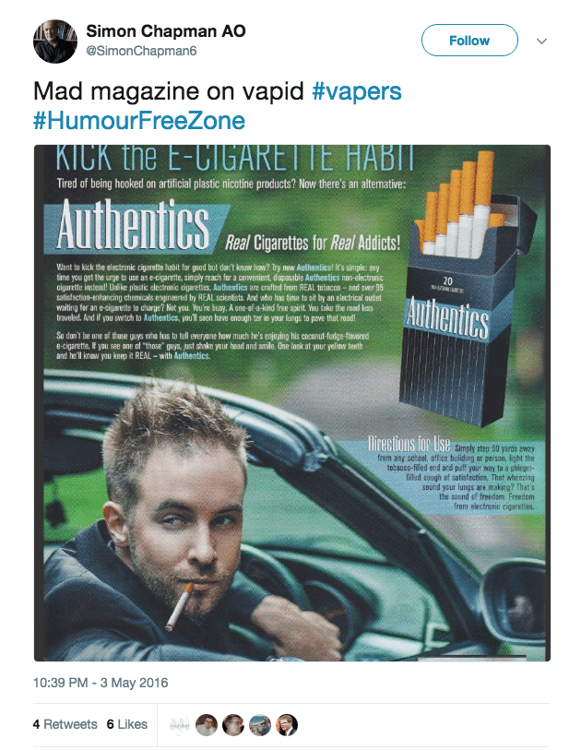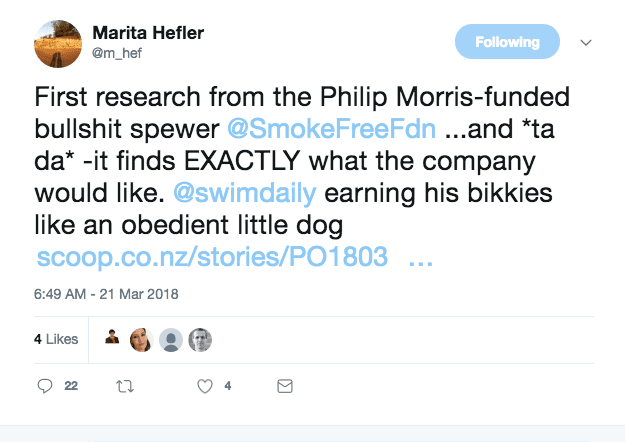Hatred is never a good strategy.
From 2012 to 2014 vaping was taking off at an exponential rate worldwide. A community of underground hardware hacking pioneers had already been working for years to improve the early e-cigarettes. Using their distributed intelligence they connected through Internet forums freely just like open source software developers, but their work was creating open source, unpatented nicotine delivery systems.
They tinkered in their sheds to increase the power, capacity and e-liquid delivery. Almost every innovation in vaping can trace its origin to these unsung, unpaid public health heroes. Their inventions were adopted by new nimble Chinese e-cigarette companies who started mass producing the devices and millions of smokers began using them.
The products had become good enough, cheap enough, and easy enough to use. Vaping created communities of ex-smokers as this far safer, far cheaper way of enjoying nicotine went viral, spreading person to person. But then this disruption came to a screaming halt.
All the old established players were deeply threatened. Big Pharma’s sales of nicotine replacement therapy were threatened. Big Tobacco’s sale of cigarettes were threatened. And much of the tobacco control establishment was deeply threatened by this sudden market disruption that challenged every tenet of their beliefs. At the core, they could not cope with the truth that for large numbers of smokers, smoking is enjoyable despite its costs.
Under this ideology, it’s better for people to smoke than to vape, because then righteous punishment in the form of death and disease will rain down upon the sinners.
They had never dealt with a consumer insurgency before. Many of them couldn’t even see it, and still don’t. Working for years in a two-dimensional world of public health heroes and Big Tobacco villains they could not imagine anything outside this framework playing a role in the rapid decline of smoking. So like a child trying to fit a round peg into a square hole — because they had no round holes available — the tobacco controllers blamed it all on Big Tobacco.
Some tobacco companies had begun making weak versions of vapes, so the tobacco controllers latched onto these as a target. Advertising was accused of being reminiscent of the old days of tobacco marketing. E-cigarettes rely on flavours to substitute one pleasure for another to maximise the chance of adults switching, but they misinterpreted this as trying to hook kids as new customers.
They had fought so hard for so long to get rid of marketing, to get rid of candy cigarettes, to get rid of anything attractive about recreational nicotine, and then vaping showed up out of nowhere and made their work pointless.
Some people in public health listened to the consumers, especially in the U.K. where there was a tradition of compassion for smokers. But in Australia, led by people like Simon Chapman, the only correct response to smoking — or anything that looked like smoking — was punishment. So the fight against these devices started early and went hard. No one dared listen to vapers or smokers, because anyone defending vaping was assumed to be a paid shill of Big Tobacco. They framed the debate as a new front in the war on Big Tobacco.
Not only did they hate Big Tobacco, they hated smokers themselves -- and they hated vapers even more, because we exposed their ideology as being morally and ethically bankrupt.
Australia has been perceived as leading the world in tobacco control, and many of the key influencers in global tobacco control are Australians. Their ideology was based on hate — first hatred for tobacco companies, but eventually even hatred for smokers themselves.
In these early years of the mass adoption of vaping, many of us tried to engage with tobacco control people in Australia. We naively thought that they shared the same goal as us, the end of smoking. We had an inherent dislike of tobacco companies ourselves; not only were their e-cigs obsolete, insipid and useless, but many of us resented the huge sums of money we had paid them for so many years and the sickness and death that their products produced.
Many of us would have been only too happy to join with public health to work together to end smoking and finish the tobacco companies then and there, by making smoking obsolete. Big Tobacco fearfully faced a “Kodak moment.” Their systems and processes were like lumbering giants, way too slow to keep up with the fiercely hot pace of vaping innovation by consumer hackers and small, adaptable manufacturers.
There was a real opportunity then for this disruptive tech to be encouraged and assisted. The digital photography industry didn’t need any help to make the once gigantic Kodak photo company obsolete, defunct, and bankrupt. Together, vapers and public health, with Government support, could very likely have made Big Tobacco obsolete and bankrupt as well.
But hatred blinded them. Not only did they hate Big Tobacco, they hated smokers themselves — and they hated vapers even more, because we exposed their ideology as being morally and ethically bankrupt.
Much like religious conservatives who hate condoms because they allow people to enjoy “immoral” behaviour without consequences, tobacco control hated vaping because it allowed people to enjoy nicotine in a smoking-like behaviour without consequences. And they see nicotine use as a deeply immoral behaviour. Just as others dream of a utopia where no one has sex outside of marriage, they dream of a utopia where nicotine enjoyment is consigned to history.
Under this ideology, it’s better for people to smoke than to vape, because then righteous punishment in the form of death and disease will rain down upon the sinners. The headquarters of this ideology, Australia, has literally enforced this into law. Here smoking is fully legal and easily available as a consumer product, and vaping is essentially banned, with penalties that in many cases exceed the penalties for the use of heroin.
Australian law explicitly protects the cigarette industry from competition, by an exemption in the Poisons Act. Every effort to put vaping and smoking on a level playing field, where they can compete equally, has been fiercely opposed by Simon Chapman and his friends.
A massive anti-vaping campaign was launched, with more zeal and more money than we’d seen in the anti-smoking efforts that came before. Research dollars were available for studies that deliberately set out to find any possible harms of vaping, while researchers looking for the benefits of vaping scrounged for money, and even had to crowdfund their work. The media and political reach of the tobacco control establishment ensured a regular supply of scare stories about exploding e-cigarettes and dangerous chemical emissions.
For them, the battle against Big Tobacco is more important than the lives of smokers and their families.
The vaping insurgency slowed to a crawl. The exponential growth phase was over. And Big Tobacco sighed in relief.
They now had time. The tobacco control establishment had given them a few years of respite. The tobacco industry could now develop their own products at their own pace. They could create tech like heat-not-burn products that the small vaping companies could not replicate. They had been given protection of their main product, cigarettes, so that they could continue to be profitable and develop their own harm reduced alternatives.
Vaping cannot be stopped. Nicotine alternatives cannot be stopped. They will eventually take over the nicotine market from cigarettes, much like snus dominates cigarettes in Sweden, and now Norway too. But the pause and delay that Big Tobacco are so very grateful for means that now these companies will continue to be part of the long term future of the nicotine market.
Vapers have realised that in fact this sector of tobacco control is their real enemy, not tobacco companies. They influence the laws that make it easier to smoke than to vape, and stigmatise and penalise vaping far more than smoking.
Marita Hefler’s Tweet (above) exemplifies their hate. Philip Morris is sponsoring research outside of the usual tobacco control paradigm. It suggests that beyond a certain point, increasing taxes has diminishing returns and creates real suffering among poor people denied alternatives to cigarettes. But the tobacco control ideologues just couldn’t care less. For them, the battle against Big Tobacco is more important than the lives of smokers and their families.
Just like it would be insane for environmentalists to hate coal companies for switching to solar, even children could see that it is mad to hate Big Tobacco for switching to cleaner alternatives. The obviousness of this cannot be hidden away forever.
I just feel so sorry for these people who hitched their cart to the wrong horse and are destined to be ridiculous figures when the history of this moment is written. They were so consumed by hatred that they were blind and deaf to reason.
Not only did they keep more people smoking and dying, they actually saved Big Tobacco — the thing they claim to hate the most.
The Freemax REXA PRO and REXA SMART are highly advanced pod vapes, offering seemingly endless features, beautiful touchscreens, and new DUOMAX pods.
The OXVA XLIM Pro 2 DNA is powered by a custom-made Evolv DNA chipset, offering a Replay function and dry hit protection. Read our review to find out more.
The SKE Bar is a 2 mL replaceable pod vape with a 500 mAh battery, a 1.2-ohm mesh coil, and 35 flavors to choose from in 2% nicotine.
Because of declining cigarette sales, state governments in the U.S. and countries around the world are looking to vapor products as a new source of tax revenue.
The legal age to buy e-cigarettes and other vaping products varies around the world. The United States recently changed the legal minimum sales age to 21.
A list of vaping product flavor bans and online sales bans in the United States, and sales and possession bans in other countries.





















